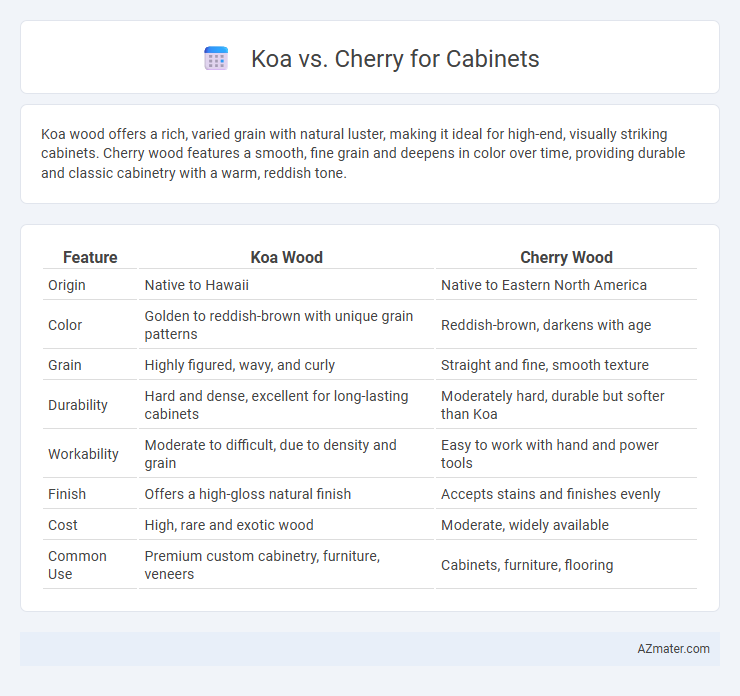Koa wood offers a rich, varied grain with natural luster, making it ideal for high-end, visually striking cabinets. Cherry wood features a smooth, fine grain and deepens in color over time, providing durable and classic cabinetry with a warm, reddish tone.
Table of Comparison
| Feature | Koa Wood | Cherry Wood |
|---|---|---|
| Origin | Native to Hawaii | Native to Eastern North America |
| Color | Golden to reddish-brown with unique grain patterns | Reddish-brown, darkens with age |
| Grain | Highly figured, wavy, and curly | Straight and fine, smooth texture |
| Durability | Hard and dense, excellent for long-lasting cabinets | Moderately hard, durable but softer than Koa |
| Workability | Moderate to difficult, due to density and grain | Easy to work with hand and power tools |
| Finish | Offers a high-gloss natural finish | Accepts stains and finishes evenly |
| Cost | High, rare and exotic wood | Moderate, widely available |
| Common Use | Premium custom cabinetry, furniture, veneers | Cabinets, furniture, flooring |
Introduction to Koa and Cherry Wood
Koa wood, native to Hawaii, is prized for its rich golden to reddish-brown hues and striking grain patterns, making it a luxurious choice for cabinet craftsmanship. Cherry wood, primarily sourced from North America, is renowned for its smooth texture, warm reddish-brown color, and natural aging process that deepens its tone over time. Both woods offer durability and aesthetic appeal, but Koa's unique coloration and rarity often position it as a premium material compared to the more readily available and traditionally elegant cherry wood.
Origin and Availability of Koa and Cherry
Koa wood, native to Hawaii, is prized for its rich, varied grain and warm tones, but its availability is limited due to its geographic restriction and conservation efforts. Cherry wood, primarily sourced from North American forests, is more widely available and valued for its smooth texture and uniform color that darkens with age. The origin of koa contributes to its rarity and higher cost, while cherry's broader distribution supports more consistent supply for cabinetry.
Visual Characteristics and Color
Koa wood exhibits a rich, warm hue with a golden to reddish-brown gradient, enhancing cabinets with a natural, vibrant grain pattern that curls or swirls, creating a dynamic visual texture. Cherry wood offers a smooth, uniform color palette that ranges from light pinkish tones to deeper reddish-brown over time, providing a classic, elegant appearance with subtle grain variations. Choosing between Koa and Cherry for cabinetry hinges on the desired aesthetic: Koa delivers a bold, exotic look, while Cherry ensures timeless, understated sophistication.
Durability and Hardness Comparison
Koa wood, known for its exceptional durability and moderate hardness rating of 3,500 on the Janka scale, offers resilience against scratches and dents, making it suitable for high-traffic cabinet areas. Cherry wood ranks slightly lower in hardness at 2,950 Janka but provides durability with a fine grain that resists warping and cracking over time, ideal for long-lasting cabinetry. Both woods exhibit strong dimensional stability, but Koa's higher hardness ensures better resistance to wear, while Cherry's workability and finishing qualities contribute to enduring cabinet aesthetics.
Workability and Craftsmanship
Koa wood offers exceptional workability with its fine grain and smooth texture, making it ideal for detailed cabinetry and intricate joinery. Cherry wood, renowned for its uniform grain and moderate hardness, allows craftsmen to achieve precise cuts and a polished finish with ease. Both woods showcase superior craftsmanship potential; Koa provides rich color variations that enhance artistic designs, while Cherry ages gracefully, deepening to a warm patina over time.
Cost and Market Value
Koa wood cabinets typically command higher market value due to their rich, distinctive grain and rarity, resulting in increased costs compared to Cherry wood cabinets. Cherry wood offers a more affordable option with a warm, smooth finish that ages gracefully, making it a popular choice for budget-conscious buyers seeking quality. The cost difference reflects Koa's exclusivity and premium status, whereas Cherry provides excellent value with broad market appeal.
Environmental Impact and Sustainability
Koa wood, native to Hawaii, offers a highly sustainable option for cabinet making due to its rapid growth and reforestation initiatives, which help reduce deforestation pressures. Cherry wood, while prized for its rich color and durability, often comes from slower-growing trees that require longer harvesting cycles, potentially impacting long-term forest sustainability. Choosing Koa supports eco-friendly sourcing with lower carbon footprints, whereas Cherry's environmental impact is tied to responsible forestry practices and certification standards like FSC.
Maintenance and Longevity
Koa wood offers exceptional durability and natural resistance to decay, requiring minimal maintenance and retaining its rich, warm appearance over time. Cherry wood, while softer and prone to dents, develops a beautiful patina with age but demands regular care to prevent surface damage and maintain its finish. Both woods benefit from periodic cleaning and conditioning, but koa's inherent hardness makes it superior for long-term cabinet longevity with less upkeep.
Popular Uses in Cabinetry Design
Koa wood is highly prized in cabinetry design for its rich, warm tones and striking grain patterns, making it a popular choice for luxury and custom cabinets. Cherry wood is renowned for its smooth texture and deepening reddish hues over time, commonly favored for traditional and elegant cabinetry. Both woods offer durability and aesthetic appeal, with Koa often used in high-end, visually impactful pieces, while Cherry suits classic, timeless designs.
Pros and Cons Summary
Koa cabinets offer rich, warm tones and unique grain patterns that enhance the aesthetic appeal of luxury interiors, with durability suited for long-term use but come at a higher price point and require more maintenance. Cherry cabinets provide a classic, smooth finish that darkens gracefully over time, offering reliable strength and resistance to wear, yet they can be prone to dents and scratches and may have a more limited color range. Both woods excel in quality, with Koa favored for its exotic beauty and Cherry preferred for its traditional elegance and consistent performance.

Infographic: Koa vs Cherry for Cabinet
 azmater.com
azmater.com